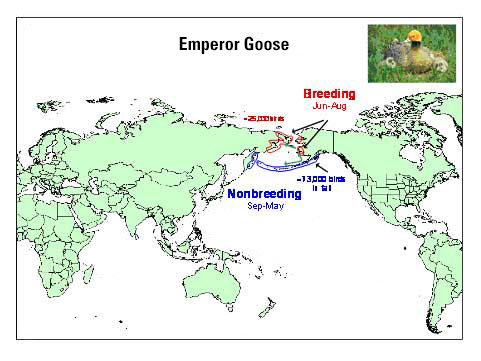Emperor Goose, Chen canagica
High-Priority Species ListSampling locations: YKD (Manokinak River, Kigigak Island) during breeding, Nelson Lagoon during fall migration, and Adak and Shemya islands in the Aleutian Islands during winter.
Sampling timeframe: June - early Aug for YKD, late Sept/early Oct for Nelson Lagoon, and January for Adak and Shemya islands.
Sample demographics: Breeding adults and 6-week old young while on YKD. Elsewhere at other times, fecal samples will not allow relation to age/sex class.
Methods of capture: Hoop or bow traps for incubating adults and traditional drive (pot) nets for capture of late summer molters. On fall and winter areas, fecal samples will be picked up when geese roost at high tide (Schmutz 1994). At these sites, we will likely also experiment with means for live capture.
Other target species: During captures on the YKD, we could also catch, if necessary, significant numbers of Black brant and small numbers of Sandhill cranes, Tundra swans, Spectacled eiders, Common eiders, Northern pintals, and Glaucous gulls, all of which are on the national list of species for priority sampling.
Contact: Fred Broerman
Alaska Maritime NWR (Adak - January)
U.S. Geological Survey
Contact: Craig Ely
Russian Academy of Sciences, Russian Ringing Centre.
Fischer, J. B, R. A. Stehn, T. D. Bowman, and G. Walters. 2005. Nest population size and potential production of geese and spectacled eiders on the Yukon-Kuskokwim Delta, Alaska, 2005. US Fish and Wildlife Service report, Anchorage, AK, 28pp.
Hupp, J. W., J. A. Schmutz, C. R. Ely, E. E. Syroechkovskiy, A. V. Kondratyev, and W. D. Eldridge. The molt migration of emperor geese between Alaska and Russia. In review for Journal of Avian Biology.
Petersen, M.R., J.A. Schmutz, and R.F. Rockwell. 1994. Emperor goose (Chen canagica). In: The birds of North America, no. 97 (A. Poole and F. Gill, eds). Phila. Acad. of Natural Science; Washington, D.C.: The American Ornithologists' Union.
Schmutz, J.A. 1994. Age, habitat, and tide effects on feeding activity of emperor geese during autumn migration. Condor 96:46-51.
Schmutz, J.A., and A.Y. Kondratyev. 1995. Evidence of emperor geese breeding in Russia and staging in Alaska. Auk 112:1037-1038.

Ranking Score: 13.0
Asian H5N1 ranking criteria for Emperor Goose, Chen canagica.
Total of partial contact with Asia1 |
Contact with known "hot spot"2 |
Habitat used in Asia3 |
Pop. in Alaska4 |
Can samples be obtained? |
Score |
2.0 |
1.0 |
4.0 |
3.0 |
3.0 |
13.0 |
Approximately 20,000 birds molt in Chukotka, several thousand breed in the Anadyr lowlands |
No known use of AI-infected areas |
Breeds moist tundra meadows and near wetlands |
Approximately 90% of the population winters in Alaska and approximately 60% summers in Alaska |
Relatively easy to trap during summer and fall molting period |

